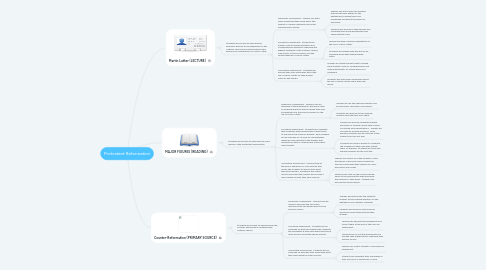
1. Martin Luther (LECTURE)
1.1. Students will be able to describe the problems that led to the weakening of the Catholic church and summarize the main beliefs and contributions of Martin Luther
1.1.1. Diagnostic Assessment: Student will write down everything they know about this subject in a group quickwrite and class brainstorming activity
1.1.1.1. Teacher will write down the answers that groups have shared on the whiteboard to gauge their prior knowledge and adjust the lesson as necessary.
1.1.1.2. Students will discuss in table groups and complete their group quickwrites then share with the class
1.1.2. Formative Assessment: Students will answer critical thinking questions and comprehension questions regarding the biggest problems of the Catholic church, main points of the 95 theses, and the lasting legacies of Martin Luther
1.1.2.1. Teacher will give a lecture presentation on the life of Martin Luther.
1.1.2.2. Students will engage with the lecture by following along while taking guided notes
1.1.3. Summative Assessment: Students will provide their own summaries about the life of Martin Luther on their guided notes as exit tickets.
1.1.3.1. Teacher will utilize the exit ticket to gauge each student's level of comprehension and make adjustments for future lessons as necessary
1.1.3.2. Students will write down summaries about the life of Martin Luther using their own words
2. MAJOR FIGURES (READING)
2.1. Students will be able to describe five major figures of the Protestant Reformation
2.1.1. Diagnostic Assessment: Students will be assessed at the beginning of the lesson with an opening question that accesses their prior knowledge from the previous lesson on the life of Martin Luther.
2.1.1.1. Teacher will ask the opening question and provide quick reminders if necessary
2.1.1.2. Students will respond to the opening question through think-pair-share.
2.1.2. Formative Assessment: Students will complete their foldables while reading then submit them at the end of the class for grading. Each foldable will be checked for its level of completeness which will demonstrate to the teacher that students are able to organize key information from the text.
2.1.2.1. Teacher will provide foldable template printouts for students along with a rubric containing clear expectations. Teacher will circulate to provide guidance. After grading, foldables will be returned to the students for the unit quiz.
2.1.2.2. Students will work in groups to complete the foldables as they read then submit them for grading. Students will study the graded foldables for the unit quiz.
2.1.3. Summative Assessment: Online voting at the end of the lesson is a fun activity that allows the students to reflect upon what they have learned. Reviewing the voting results along with the reasons will provide a quick review of what they have learned.
2.1.3.1. Teacher will collect all of the students' votes through an online form then present the top picks along with their reasons for class discussion and review.
2.1.3.2. Students will vote on the most influential figure of the reformation while providing the reasons for their picks. Students will discuss the voting results.
3. Counter-Reformation (PRIMARY SOURCE)
3.1. Students will be able to describe how the Counter-Reformation revitalized the Catholic church
3.1.1. Diagnostic Assessment: Students will be asked to describe the five major reformers that we learned about in the previous lesson
3.1.1.1. Teacher will write down the students' answers to the opening question on the whiteboard via a graphic organizer
3.1.1.2. Students will be given some time for discussion before they provide their answers
3.1.2. Formative Assessment: Students will be assessed on how thoroughly they complete the worksheet & how effectively they teach other groups during the jigsaw activity.
3.1.2.1. Teacher will handout the worksheets and collect them at the end of the class for assessment
3.1.2.2. Students will fill out the worksheets and provide their presentations regarding their primary source
3.1.3. Summative Assessment: Students will be assessed on how well they summarize what they have learned in their journals.
3.1.3.1. Teacher will collect students' summaries for assessment
3.1.3.2. Students will complete their summaries in their journals in 5 sentences or more

